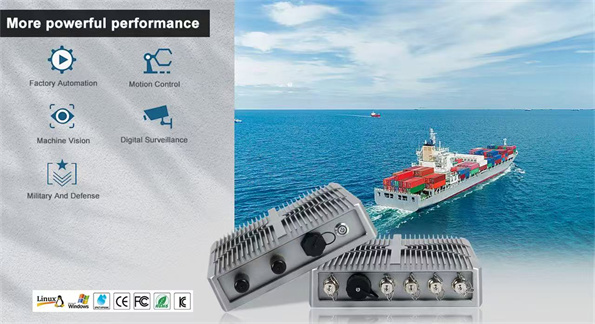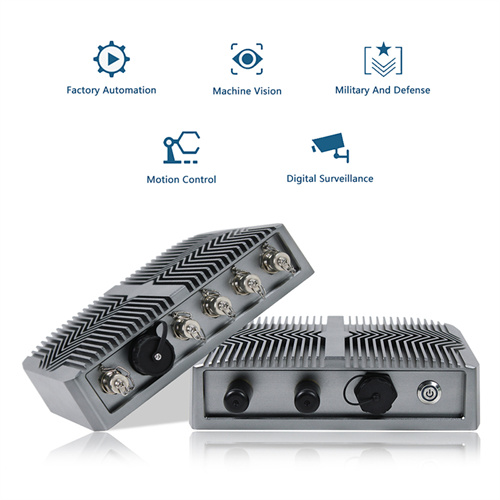Outdoor Computers

What is Outdoor Computer?
The ability of outdoor computers to function in such extreme environments is largely due to the use of components rated for wide temperature ranges and their reliance on passive cooling methods. Unlike standard desktop PCs, these systems are built to operate consistently and effectively across temperature extremes that would otherwise compromise typical computers.
Moreover, outdoor PCs utilize heatsinks to facilitate passive cooling. These heatsinks transfer heat away from internal components to the external casing, where it is dissipated into the surrounding air. This method avoids the need for fans or vents.
By adopting passive cooling, engineers have eliminated all openings and ventilation ports, resulting in a fully sealed enclosure. This design prevents the intrusion of dust, debris, and sometimes water, thereby protecting internal components from damage and failure.
How Are Outdoor Computers Different from Indoor Industrial PCs?
- • Durability: Outdoor computers typically feature corrosion-resistant metals like stainless steel or aluminum alloy for housings, designed to resist rust and physical damage.
- • Environmental Resistance: They achieve high IP ratings (Ingress Protection), often IP65 to IP69K, ensuring protection against water jets, dust ingress, and even high-pressure cleaning.
- • Thermal Design: These devices operate across a wide temperature range, sometimes from as low as -30°C up to +70°C, employing fanless cooling to reduce failure points.
- • Display Technology: Outdoor computers use ultra-bright, sunlight-readable screens with anti-reflective coatings and optical bonding, allowing clear visibility even under direct sun.
- • Power and Connectivity: Support for wide input voltage ranges, surge protection, and multiple communication protocols makes them adaptable to varied power sources and networks.
Common Challenges Faced by Outdoor Computers
Operating electronics outdoors exposes them to multiple environmental stressors. Understanding these is crucial when selecting or deploying an outdoor computer:
1. Temperature Extremes
Fluctuations between freezing winters and hot summers require computers to sustain stable operation in a wide thermal range without overheating or freezing.2. Sunlight and Visibility
Standard LCD screens wash out under bright sunlight, making touch or display-based interaction difficult. High brightness (over 1000 nits) and optical bonding technologies solve this issue.3. Moisture and Rain
Water ingress can damage circuits; therefore, IP-rated enclosures with waterproof seals are mandatory.4. Dust and Particulates
Dusty environments such as construction sites or farms necessitate dustproof housings and sealed ports.5. Corrosion and Salt Fog
For applications near the sea or chemical plants, corrosion-resistant materials and coatings are vital to extend lifespan.6. Mechanical Shock and Vibration
Industrial vehicles or outdoor machinery cause constant vibration, requiring shock-absorbent mounting and internal component reinforcement.7. Power Supply Variations
Voltage spikes, brownouts, or inconsistent power sources in outdoor settings demand robust power management and surge protection.
What Makes a Computer Suitable for Outdoor Use?
High Ingress Protection (IP) Rating
Wide Operating Temperature Range
Industrial-Grade Components
Shock and Vibration Resistance
Power Management
Why Do You Need an Outdoor Computer?
Outdoor computers address a fundamental challenge: How to maintain reliable computing power in environments where normal devices quickly fail. Here are some practical reasons why they are essential:
Extreme Weather Tolerance
From heavy rain, snow, and high humidity to blistering sun, extreme cold, and salt fog near coastal regions, outdoor computers are engineered to withstand conditions that would quickly render standard electronics inoperable. Their specialized enclosures and internal components are designed to repel moisture, dissipate heat, and resist corrosion, ensuring consistent performance regardless of the elements.
Continuous Operation
Many outdoor applications, such as environmental monitoring, industrial automation, surveillance, and remote data acquisition, demand 24/7 uptime without manual intervention. Outdoor computers are built with industrial-grade components and advanced thermal management systems to sustain continuous operation, minimizing downtime and ensuring the uninterrupted flow of critical data or control signals.
Data Integrity and Security
In remote or harsh locations, protecting critical data from environmental damage and cyber vulnerabilities is paramount. Rugged outdoor systems provide enhanced physical security against tampering and theft, while their robust design safeguards internal components from shocks, vibrations, and temperature fluctuations that could lead to data loss. Furthermore, many outdoor computers integrate advanced security features to protect against unauthorized access and cyber threats in distributed networks.
Reduced Maintenance Costs
The upfront investment in an outdoor computer is often offset by significant long-term savings. Their robust design means fewer breakdowns, reduced need for costly field repairs or replacements, and less frequent service calls to remote locations. This translates to lower operational expenditures and a higher return on investment over the lifespan of the system.
Enhanced Reliability in Critical Applications
In sectors like defense, transportation, smart city infrastructure, and agriculture, the failure of a computing device can have severe consequences, from operational disruptions to safety hazards. Outdoor computers provide the indispensable reliability required for these critical applications, ensuring that essential functions continue uninterrupted even in the most challenging environments.
Expanded Deployment Possibilities
Without outdoor computers, many innovative applications in remote or extreme environments would simply not be feasible. They enable the deployment of IoT sensors in agricultural fields, control systems in oil and gas pipelines, digital signage in public spaces, and surveillance cameras in wilderness areas, opening up new possibilities for data collection, automation, and connectivity where conventional technology cannot venture.
Where Can You Buy Outdoor Computers?
InnoAioT is a leading manufacturer of industrial computers, offering competitive pricing and a wide range of outdoor computing solutions. These solutions are suitable for both cabinet installations and direct outdoor deployments.
No need to worry — our outdoor computers support multiple mounting options and feature rich I/O configurations to ensure seamless integration into your operating environment. At InnoAioT, we are committed to delivering computer solutions that meet and exceed customer expectations.
InnoAioT Outdoor Computers
Waterproof Edge Computer

InnoAioT’s waterproof edge computer is specifically designed for outdoor deployment, providing rugged durability and reliability in the harshest environments. These waterproof edge computers are rated IP67 and IP69K for protection against dust and water. An IP67-rated system can withstand complete immersion in water up to 1 meter deep for up to 30 minutes. An IP69K-rated device offers protection against dust ingress and close-range, high-pressure, high-temperature water jets.
Key Features:
- • IP67/IP69K waterproof protection
- • Rugged and compact, fanless box design
- • 12th Gen Intel® Alder Lake Core™ i3 / i5 / i7 processor
- • Operating temperature range: -30°C to 70°C
- • Aluminum alloy housing
- • Robust M12 connectors
- • 2 x DDR5 4800MHz SODIMM slots
- • TPM 2.0 security
